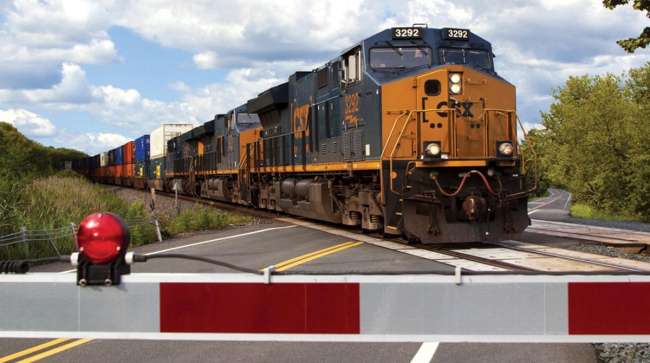Senior Reporter
Dozens of Dangerous Rail Crossings Will Be Eliminated

[Stay on top of transportation news: Get TTNews in your inbox.]
The Federal Railroad Administration has awarded more than $570 million in Railroad Crossing Elimination Grant Program funding to 32 states to improve safety and mitigate traffic backups at 400 at-grade crossings nationwide.
This inaugural round of funding will address grade crossings nationwide, improve safety, and make it easier to get around railroad tracks by adding grade separations, closing at-grade crossings, and improving existing at-grade crossings where train tracks and roads intersect, FRA said.
Last year, there were more than 2,000 highway-rail crossing collisions in the U.S. and more than 30,000 reports of blocked crossings submitted to FRA’s public complaint portal.
“Every year, commuters, residents and first responders lose valuable time waiting at blocked railroad crossings — and worse, those crossings are too often the site of collisions that could be prevented,” Transportation Secretary Pete Buttigieg said in a statement.
Today, over $570 million in Railroad Crossing Elimination Program funding is being awarded to 63 projects in 32 States through @POTUS Bipartisan Infrastructure Law. See all the projects here: https://t.co/Ql91j3am7Y pic.twitter.com/xR849UxEkS — The FRA (@USDOTFRA) June 5, 2023
FRA said that for years it has received complaints from citizens, states and localities regarding the delays and disruptions caused by frequently blocked crossings that force residents to wait hours at intersections or take detours.
The delays and disruptions also can prevent first responders from getting to emergencies quickly, FRA said.
“The Railroad Crossing Elimination Grant Program is another critical tool that FRA is using to make a lasting impact on the safety and transportation needs of communities nationwide,” said FRA Administrator Amit Bose. “With these project selections and the many more that are to come, we will save lives and reshape infrastructure in ways that allow individuals to move through their neighborhoods seamlessly and safely.”
Along with projects that build or upgrade physical infrastructure at railroad crossings, FRA awarded $15.7 million for planning activities and $33.1 million for project development and design activities that will build a pipeline of projects for future funding. Some of the larger awards:
- The West Belt Improvement Project in Houston (Phase 1) for $37 million
- The Railroad Crossing Elimination on Shelby County Road in the city of Pelham, Ala., for $41.7 million
- The Governors Parkway Railroad Overpass Project in the city of Hammond, Ind., for $7 million
- The Broward County Sealed Corridor Project in Broward County, Fla., for $15.4 million
- Unlocking the Iron Triangle: Grade Separation of S Town Street in Fostoria, Ohio, for $7.2 million
- The 32nd Street Underpass Project in Washougal, Wash., for $40.2 million
The challenges with highway railroad crossings date back many years, but in 2019 the FRA issued a proposed rule that would require states to develop highway-rail grade crossing action plans — or update the action plans they have.
At that time the Federal Motor Carrier Safety Administration said there were more than 250,000 such crossings, and FRA reported that 94% of all rail-related fatalities and injuries occur at railroad crossings or due to trespassing, which caused more than 400 rail-related fatalities each year.
We announced funding for 63 projects across 32 states to improve hundreds of rail crossings nationwide.
Removing these crossings will alleviate traffic bottlenecks, move trains smoother, and protect the communities who navigate them daily.https://t.co/QGX2vVqLvP — TransportationGov (@USDOT) June 5, 2023
In December 2020, FRA published a final rule requiring 40 states and the District of Columbia to develop and implement highway-rail grade crossing action plans to improve public safety. In addition, the rule required 10 states that already had developed grade-crossing action plans to update their plans and submit reports describing the actions they have taken to implement them.
“Grade-crossing accidents and incidents are the second leading cause of rail-related deaths in the United States, but nearly every one of them is preventable,” FRA Administrator Ronald Batory said at the time. “The action plans give states a tool to engage with federal and local partners, railroads and rail safety advocates to identify high-risk crossings and develop strategies to save lives.”
Want more news? Listen to today's daily briefing below or go here for more info:




